The Fibreglass Trays Market is estimated to be valued at USD 1.3 billion in 2025 and is projected to reach USD 2.0 billion by 2035, registering a compound annual growth rate (CAGR) of 4.6% over the forecast period.
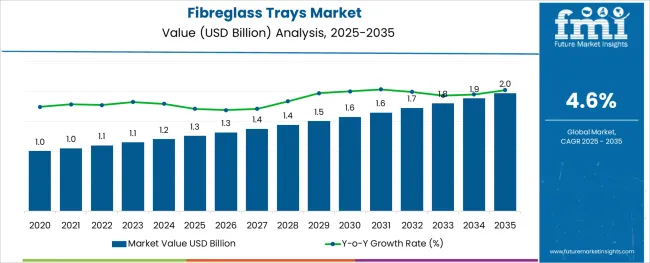
The fibreglass trays market is experiencing stable expansion driven by increasing demand for durable, lightweight, and heat-resistant food service solutions. Fibreglass trays are being widely adopted in institutional catering, quick service restaurants, and healthcare settings due to their long service life, resistance to breakage, and ease of sanitization. The market is being influenced by regulatory compliance surrounding food safety and the rising need for hygienic, non-porous food handling equipment.
Manufacturers are investing in compartmentalized, stackable, and ergonomic tray designs to enhance user convenience and operational efficiency. Additionally, the shift toward eco-friendly alternatives to single-use plastic trays is supporting the transition to fibreglass as a sustainable mid- to long-term solution.
With food delivery platforms and online foodservice channels expanding rapidly, the demand for quality trays suitable for both dine-in and off-premise settings is expected to remain strong. As commercial kitchens and institutional buyers focus on lifecycle value, customization, and sustainability, fibreglass trays are positioned to maintain growth across diverse end use sectors.
The market is segmented by Design, End Use, and Distribution Channel and region. By Design, the market is divided into With Compartment and Without Compartment. In terms of End Use, the market is classified into Food & Beverage, Healthcare, Households, and Other Consumer Goods. Based on Distribution Channel, the market is segmented into Online and Offline. Regionally, the market is classified into North America, Latin America, Western Europe, Eastern Europe, Balkan & Baltic Countries, Russia & Belarus, Central Asia, East Asia, South Asia & Pacific, and the Middle East & Africa.
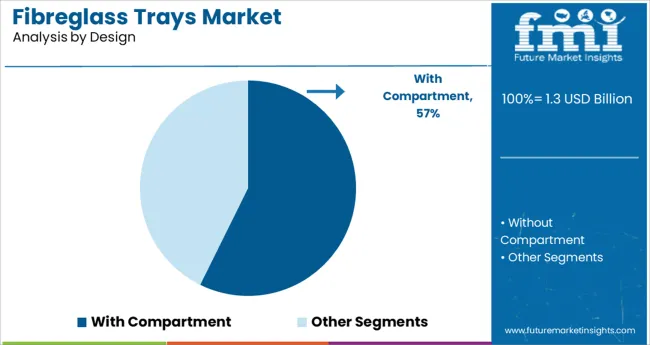
The with compartment design segment is anticipated to hold 57.3% of market revenue in 2025, making it the leading configuration by design. This leadership is being driven by the functional benefits of portion control, spill prevention, and cross-contamination reduction, which are particularly valued in foodservice and institutional environments.
Compartmentalized trays are preferred in school cafeterias, hospitals, and fast casual settings for serving multi-item meals efficiently while maintaining food separation. Their adoption has also been strengthened by ergonomic improvements and designs tailored for dishwasher compatibility and stacking convenience.
Additionally, regulatory emphasis on hygiene and operational speed has encouraged procurement of trays that support quick and organized service. The consistent demand for structured meal presentations in high-volume food operations is expected to maintain the dominance of compartment-based tray designs.
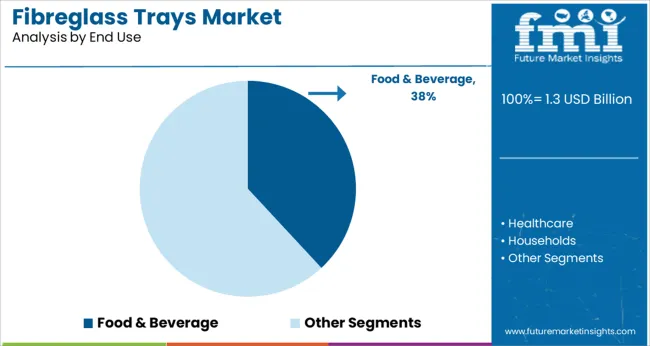
The food and beverage segment is projected to contribute 38.1% of total market revenue in 2025, establishing it as the top end use sector. This growth has been driven by increased adoption of fibreglass trays across commercial dining establishments, catering services, and institutional kitchens.
Trays made from fibreglass offer long-term durability, heat resistance, and reduced maintenance costs, making them ideal for high-traffic environments. Their ability to withstand frequent washing and resist staining supports compliance with food safety standards, further reinforcing their role in modern foodservice operations.
Growing demand for reusable serviceware in quick service restaurants and casual dining formats has also favored this segment. As the food and beverage industry continues to prioritize sustainable, cost-efficient, and high-performance service solutions, fibreglass trays are expected to remain a preferred choice across kitchen and front-of-house operations.
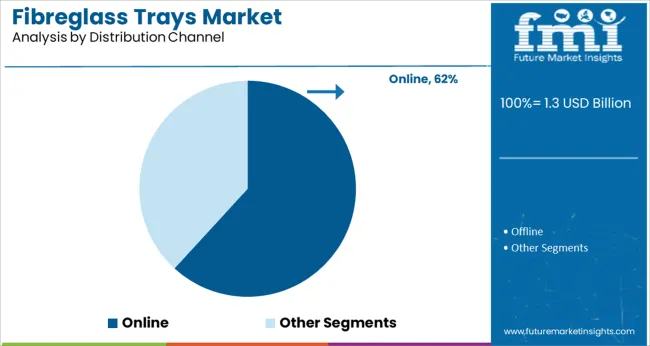
The online distribution channel segment is expected to capture 61.8% of market revenue in 2025, emerging as the dominant sales route. This position is being supported by the growing preference for digital procurement among commercial buyers, foodservice operators, and institutional purchasers seeking quick access to a wide array of tray formats and specifications.
E-commerce platforms have enabled manufacturers and distributors to reach end users directly with customizable options, bulk order capabilities, and real-time inventory access. Additionally, online platforms support transparent pricing, customer reviews, and logistics optimization, which are valued by procurement managers in the hospitality and healthcare sectors.
The rise of B2B e-commerce ecosystems and marketplace integrations has further expanded the online footprint of fibreglass tray vendors. As digital purchasing continues to accelerate in the commercial kitchen and hospitality supply space, the online channel is expected to maintain its leadership in distribution.
Exponential growth of end-use industries due to population explosion and increasing consumer spending, growing awareness among people regarding the benefits of fiberglass trays, and innovations in fiberglass tray design and sizes are some of the major factors driving the growth in fiberglass trays market.
Fiberglas trays have become ideal solutions for material handling applications across various end use verticals such as foodservice, pharmaceuticals, and bakery & confectionery. They are preferred over other traditional trays on account of their functionality, lightweight, durability, and heat resistant nature.
The robust growth of foodservice industry due to rapidly growing world population and changing lifestyle is creating enormous demand for more convenient products like fiberglass trays and the trend is likely to continue in the future. These fiberglass trays are being used in cafeterias, restaurants, motels etc. for carrying or transporting food from the serving area to the dining area.
What really makes fiberglass trays suitable for serving food products, especially hot ones, is their ability to withstand higher temperatures. Today, majority of food serving companies are inclined towards using fiberglass trays as they offer better service, are more hygienic, and can be cleaned easily. Increasing adoption of fiberglass trays coupled with rapid expansion of foodservice industry will continue to push the sales of fiberglass trays during the assessment period.
Moreover, rising usage of fiberglass trays across households for serving food products and several other applications will further expand the size of fiberglass trays market during the forthcoming years.
In addition to this, easy availability of various fiberglass tray products at discount across online shopping platforms, supermarkets, convenience stores, specialty stores, etc. is positively impacting the market growth.
Despite rising popularity of fiberglass tries across food and pharmaceutical industries, there are various factors that are likely to challenge market growth in the forthcoming years. Some of these factors are the presence of low-cost alternatives and poor product penetration across some developing and underdeveloped regions.
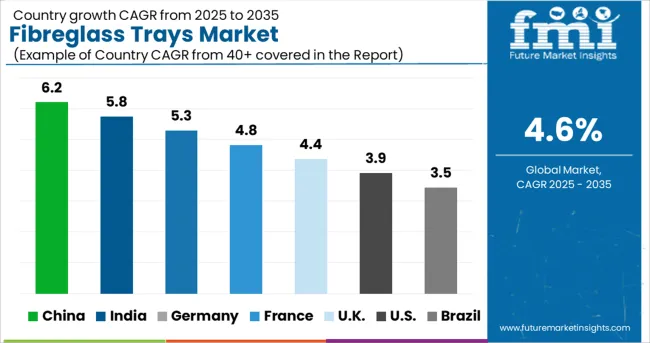
With rapid expansion of end-use industries, rapidly growing population, changing lifestyle, and increasing spending by people on food products, the Asia Pacific fiberglass trays market is projected to grow at a faster pace during the forecast period.
Demand for fiberglass trays is particularly high across fast growing countries like China and India due to their multiple applications in several industries such food & beverages, bakery, and pharmaceuticals. These fiberglass trays are being increasingly used for carrying things and serving food items.

According to Future Market Insights, Western Europe accounts for a significant share of the global fiberglass trays market and is forecast to grow at a notable CAGR over the forecast period, owing to the rapid expansion of bakery and confectionery industry, flourishing HoReCa sector, and presence of some leading market players.
Countries such as Germany, Poland, Belgium, UK and Czech Republic are all generating high demand for fiberglass trays, as these regions are witnessing an uptick in foodservice and tourism.
Besides this, increasing adoption of fiberglass trays in pharmaceutical and confectionery industries for material handling purposes will further boost the market growth across Europe during the assessment period.
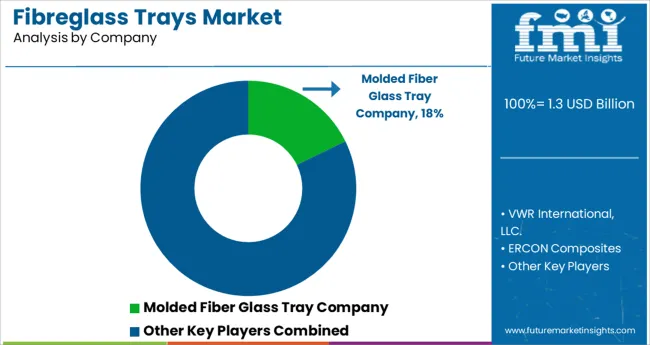
Some of the key participants present in the global fiberglass trays market include Huhtamaki Group, Roltex NV, Carlisle FoodService Products, Molded Fiber Glass Trays Company, Keswick Trays, and Shawson Plastics among others.
These market players are continuously introducing new fiberglass trays with multiple designs, features, and capacities to woo more and more customers. Furthermore, they have adopted growth strategies such as partnerships, establishment of new manufacturing facilities, reduction in product prices, and move towards online sales channels to gain a competitive edge in the market.
| Report Attribute | Details |
|---|---|
| Growth Rate | CAGR of 4.2% - 4.6% from 2025 to 2035 |
| Base Year for Estimation | 2024 |
| Historical Data | 2020 to 2024 |
| Forecast Period | 2025 to 2035 |
| Quantitative Units | Revenue in million and CAGR from 2025 to 2035 |
| Report Coverage | Revenue Forecast, Volume Forecast, Company Ranking, Competitive Landscape, Growth Factors, Trends and Pricing Analysis |
| Segments Covered | Product Type, Application, Region |
| Regions Covered | North America; Latin America; Western Europe; Eastern Europe; APEJ; Japan; Middle East and Africa |
| Key Countries Profiled | USA, Canada, Brazil, Argentina, Germany, UK, France, Spain, Italy, Nordics, BENELUX, Australia & New Zealand, China, India, ASEAN, GCC, South Africa |
| Key Companies Profiled | Huhtamaki Group; Roltex NV; Carlisle FoodService Products; Molded Fiber Glass Trays Company; Keswick Trays; Shawson Plastics |
| Customization | Available Upon Request |
The global fibreglass trays market is estimated to be valued at USD 1.3 billion in 2025.
It is projected to reach USD 2.0 billion by 2035.
The market is expected to grow at a 4.6% CAGR between 2025 and 2035.
The key product types are with compartment and without compartment.
food & beverage segment is expected to dominate with a 38.1% industry share in 2025.






Our Research Products

The "Full Research Suite" delivers actionable market intel, deep dives on markets or technologies, so clients act faster, cut risk, and unlock growth.

The Leaderboard benchmarks and ranks top vendors, classifying them as Established Leaders, Leading Challengers, or Disruptors & Challengers.

Locates where complements amplify value and substitutes erode it, forecasting net impact by horizon

We deliver granular, decision-grade intel: market sizing, 5-year forecasts, pricing, adoption, usage, revenue, and operational KPIs—plus competitor tracking, regulation, and value chains—across 60 countries broadly.

Spot the shifts before they hit your P&L. We track inflection points, adoption curves, pricing moves, and ecosystem plays to show where demand is heading, why it is changing, and what to do next across high-growth markets and disruptive tech

Real-time reads of user behavior. We track shifting priorities, perceptions of today’s and next-gen services, and provider experience, then pace how fast tech moves from trial to adoption, blending buyer, consumer, and channel inputs with social signals (#WhySwitch, #UX).

Partner with our analyst team to build a custom report designed around your business priorities. From analysing market trends to assessing competitors or crafting bespoke datasets, we tailor insights to your needs.
Supplier Intelligence
Discovery & Profiling
Capacity & Footprint
Performance & Risk
Compliance & Governance
Commercial Readiness
Who Supplies Whom
Scorecards & Shortlists
Playbooks & Docs
Category Intelligence
Definition & Scope
Demand & Use Cases
Cost Drivers
Market Structure
Supply Chain Map
Trade & Policy
Operating Norms
Deliverables
Buyer Intelligence
Account Basics
Spend & Scope
Procurement Model
Vendor Requirements
Terms & Policies
Entry Strategy
Pain Points & Triggers
Outputs
Pricing Analysis
Benchmarks
Trends
Should-Cost
Indexation
Landed Cost
Commercial Terms
Deliverables
Brand Analysis
Positioning & Value Prop
Share & Presence
Customer Evidence
Go-to-Market
Digital & Reputation
Compliance & Trust
KPIs & Gaps
Outputs
Full Research Suite comprises of:
Market outlook & trends analysis
Interviews & case studies
Strategic recommendations
Vendor profiles & capabilities analysis
5-year forecasts
8 regions and 60+ country-level data splits
Market segment data splits
12 months of continuous data updates
DELIVERED AS:
PDF EXCEL ONLINE
ESD Trays Market Size and Share Forecast Outlook 2025 to 2035
Lab Trays Market Size and Share Forecast Outlook 2025 to 2035
Meat Trays Market Analysis - Size and Share Forecast Outlook 2025 to 2035
Key Companies & Market Share in the Food Trays Sector
CPET Trays Market
Sieve Trays Market Size and Share Forecast Outlook 2025 to 2035
Pharma Trays Market Size, Share & Forecast 2025 to 2035
Correx Trays Market
Insert Trays Market
Syringe Trays Market
PET Food Trays Market Size and Share Forecast Outlook 2025 to 2035
Assembly Trays Market Size and Share Forecast Outlook 2025 to 2035
Market Share Breakdown of Assembly Trays Manufacturers
Bakeable Trays Market
Cardboard Trays Market Size, Share & Forecast 2025 to 2035
Dispensing Trays Market Size, Share & Forecast 2025 to 2035
Trach Care Trays Market
Autoclaving Trays Market Trends - Growth & Forecast 2025 to 2035
Key Companies & Market Share in the Containment Trays Sector
Compartment Trays Market

Thank you!
You will receive an email from our Business Development Manager. Please be sure to check your SPAM/JUNK folder too.
Chat With
MaRIA